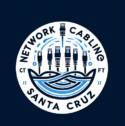What Is the Fastest Network Cable? A Complete Guide to High-Speed Ethernet Options
When it comes to internet speed, your cable matters more than you might think. Even with the best router or modem, your connection can only go as fast as your cables allow. So, what is the fastest network cable available today? Let’s explore the different Ethernet cable types, their speeds, and which one is right for your setup. Our team of experienced network cabling professionals in Santa Cruz ensures every installation meets top performance standards for speed and reliability.
Understanding Network Cable Categories
Ethernet cables are classified into “categories,” or Cat for short. Each category has its own speed and bandwidth rating based on performance standards. The most common types are Cat5e, Cat6, Cat6a, Cat7, and Cat8 — each one representing an improvement in speed, frequency, and shielding.
Here’s a quick overview:
| Cable Type | Maximum Speed | Maximum Frequency | Ideal Use Case |
|---|---|---|---|
| Cat5e | Up to 1 Gbps | 100 MHz | Home and small office networks |
| Cat6 | Up to 10 Gbps (short distances) | 250 MHz | Modern home and business networks |
| Cat6a | Up to 10 Gbps | 500 MHz | Large offices, data-heavy environments |
| Cat7 | Up to 10 Gbps | 600 MHz | Industrial and high-end commercial networks |
| Cat8 | Up to 40 Gbps | 2000 MHz | Data centers, server rooms, enterprise systems |
The Fastest Network Cable: Cat8
As of today, Cat8 (Category 8) is the fastest commercially available Ethernet cable. It supports speeds up to 40 Gbps and bandwidth up to 2000 MHz, making it ideal for data centers, enterprise networks, and high-performance computing environments.
Unlike earlier categories, Cat8 cables are heavily shielded to reduce interference and crosstalk, ensuring ultra-stable transmission even over short distances (up to 30 meters).
Key advantages of Cat8 cabling include:
- Ultra-high speed for data-intensive environments
- Superior shielding that prevents signal loss
- Compatibility with older standards (backward compatible with Cat6 and Cat6a)
- Future-proofing for next-generation network demands
Cat6 and Cat6a: The Best Options for Most Users
While Cat8 offers unmatched speed, it’s often overkill for home or small business networks. Most people will find Cat6 or Cat6a to be the perfect balance of speed, affordability, and reliability.
- Cat6 is ideal for homes and small offices that need Gigabit speeds and light 10G support for shorter runs.
- Cat6a doubles the bandwidth and provides consistent 10 Gbps performance across longer distances (up to 100 meters).
These cables are also easier to install, more flexible, and less expensive than Cat7 or Cat8 options — making them the go-to choice for network cabling installations in homes and offices.
Cat7: A Bridge Between Cat6a and Cat8
Cat7 is another high-performance cable that supports 10 Gbps speeds, but it comes with individual shielding on each wire pair, offering better protection against interference. It’s mostly used in industrial environments or data-heavy commercial spaces, where signal integrity is crucial.
However, Cat7 uses non-standard connectors (GG45 or TERA), which can make it less compatible with typical RJ45 Ethernet ports. For that reason, Cat6a or Cat8 are often preferred for new installations. If you’re looking for the best options for faster connectivity, check out our guide on which cable is used for high-speed internet.
Choosing the Right Network Cable for Your Needs
Here’s a quick guide to help you pick the best cable:
- Home networks: Cat6 or Cat6a
- Small businesses: Cat6a for future scalability
- Gaming or streaming setups: Cat6a for stable, low-latency performance
- Large offices or enterprises: Cat7 or Cat8 for maximum reliability and speed
- Data centers: Cat8 for 40 Gbps backbone performance
When planning your installation, also consider cable length, environment (plenum vs. riser rated), and shielding (STP vs. UTP) — all of which affect overall performance and compliance with building codes.
Why Professional Installation Makes a Difference
Even the fastest cable won’t perform at its best without proper installation. Professional structured cabling contractors ensure your network is designed, routed, and terminated to meet both performance standards and local electrical codes.
Certified installers:
- Test every connection for optimal speed and signal quality
- Use quality components and cable management techniques
- Ensure compliance with ANSI/TIA-568 standards
- Provide documentation and warranty support
A professionally installed system guarantees that your investment delivers the speed and reliability you’re paying for.
Future-Proofing Your Network
With rapid advances in cloud computing, smart devices, and high-definition media, bandwidth needs are growing fast. Investing in higher-category cables like Cat6a or Cat8 now can save you from costly upgrades later.
Structured cabling designed with future scalability in mind ensures your system can easily adapt to new technologies — keeping your business or home network performing at its best for years.
Final Thoughts
So, what is the fastest network cable? The answer is Cat8, capable of up to 40 Gbps of lightning-fast data transfer. However, for most homes and businesses in California and beyond, Cat6a remains the most practical and cost-effective choice. Many people wonder whether fiber counts as a type of cable — find out the answer in our post, is fiber optic a cable?.
Whichever you choose, make sure your cabling system is installed by qualified professionals to maximize performance, reliability, and safety.
